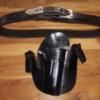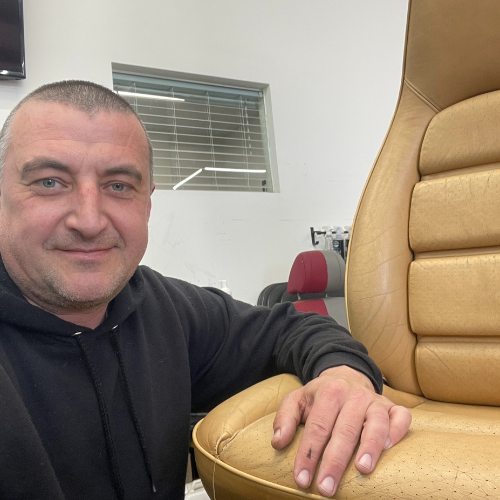All Activity
- Past hour
-

Sewing machine for true moccasin footwear
Wizcrafts replied to X24's topic in Leather Sewing Machines
Redwing boots are sewn on Puritan chainstitch machines. Some have 4 or more needles to sew parallel lines at critical seams on the boots. I guess it wouldn't hurt to contact them and ask if they have any Puritans they want to sell off. - Yesterday
-
Agreed. My current thoughts are to motorized the CLSP and get all I can from it. I think I'll keep an eye out for a Puritan chain stitcher, because they clearly work well for this style of construction.
-
Development of best servo motor for leather sewing machine
GerryR replied to CowBoyOUTLAW's topic in Leather Sewing Machines
In the system I have (AC-VFD), the motor is spec'd at 35-459 RPM, 10-90 Hz. That is the output from the 5:1 reducer (gearmotor). I have a 1-1/2" motor pulley going to a 7" drive pulley for another 4.67 reduction giving 7.5 RPM at the machine at 10 Hz (minimun specified operating frequency for the motor), which amounts to 0.125 revs.per second or 1 revolution every 8 seconds. But that is not the point. The point is that when I hit the pedal, and the motor starts to move, I am easily in the safe operating zone of the motor, 10 Hz minimum. It would be absurd to run the machine at 1 stitch every 8 seconds for any length of time. The idea is to keep the motor happy and stll be able to do some controlled slow stitching. Just my $.02 -
Maybe motorizing the patcher will be all you need. If not, buy whichever machine will replace the most work for you. Sewing machines are a deep, expensive rabbit hole.
-
Despite all of the improvements made in electronic motors over the last almost 20 years, I can still feather a clutch motor so it barely turns over the machine, and hold it at a slow and steady speed. Yes, they are noisy and generate a bit of heat. But, they are like the Ever Ready Bunny: they just keep on going! If anybody reads this and is having trouble controlling a clutch motor, try backing off the big screw on the clutch housing. This adds a certain amount of slack movement before the disks engage. You can also tighten the coil spring that holds back the clutch lever. That keeps the lever up and away from engaging accidentally. Finally, you can smear a little grease on the internal cork disk that mashes into the main disks. The final adjustment is to replace a large motor pulley with a 2 inch pulley, or to add a 2:1 speed reducer.
-

Development of best servo motor for leather sewing machine
AlZilla replied to CowBoyOUTLAW's topic in Leather Sewing Machines
Of course, I had to run the numbers. A 30MM motor pulley, (2) 2:6 reducers and a 3.5" hand wheel gives a 1:31.5 reduction. 100 RPM becomes 3.2 at the hand wheel. 20 seconds per stitch! -
I highly suspected that was the case, I was just curious if anyone more experiencd had any other ideas. I will likely just motorize my CLSP for now, as my main complaint is not having two hands to hold the work piece when stitching. Neither a cylinder arm, nor a post bed, can sew everything I'd like on my uppers. But this stupid little manual machine can do most things I want. And it can push thick thread through a good chunk of material. To replace it, I'd basically need to grab a cylinder arm and post bed at the same time.
-

Development of best servo motor for leather sewing machine
dikman replied to CowBoyOUTLAW's topic in Leather Sewing Machines
I did that once - a snail was fast in comparison! An interesting experiment but not very practical. Bottom line here is the Kinedyne (Hightex) motor is doubtless a good motor but if I had one, which isn't likely given the cost, I would still fit a speed reducer. And I don't need all the other gimmicks fitted to it. -

Singer 45k25 - is it worth $1200?
dikman replied to MackProvisions's topic in Leather Sewing Machines
Yep, pass on it. Old machines like that are a) good for restorers, b) good for collectors or c) could be a useful machine for someone who knows what they're doing - IF the price is right. Which it isn't. -
Farming is definitely one of the more hazardous occupations there is. My great-grandfather was killed back in the early 1900's when the horses were frightened by one of those newfangled 'horseless carriages' and ran away. He fell off the seat of the reaper, and his foot got caught in the sheaf carrier strap. He was dragged back to the barn with his head banging on the ground, and suffered a fatal brain injury. My dad's youngest brother was using the hay elevator to load corn cobs into a silo, and the cuff of his overalls got caught on the elevator. The woman helping him didn't know where the shutoff switch was, so had to run a fair distance to unplug the cord from the outlet. By that point, Gord was hanging from the top of the elevator by his ankles, with the elevator belt running over them. He was in a wheelchair for a couple of months. They set up an intercom system from the house to the barn, so he could supervise his sons while they were doing the milking and chores. That did not always go well. One day they got into a fight while Gord and his wife were entertaining company. The language coming over the intercom wasn't exactly 'family friendly'! Another time, his second oldest son was riding on the back of the tractor while his father was moving a disc harrow from one field to another. When he hit the hump from the field to the grass, his son fell off and was run over by the harrow. Broken leg and some internal injuries. Thank God it wasn't the chisel harrow... His friends at school weren't very sympathetic. They'd stick tacks in the rubber ends of his crutches so they'd slip on the floor... When my dad was in his old age, he developed respiratory problems, probably as the result of all the dust he inhaled while working on the farm. His chest x-ray showed a healed fracture of one of his ribs. "When did you break a rib?" I asked. He had to think for quite a few minutes. "I guess it was the time I stepped back so my dad could drive the Model T into the barn loft, and someone had left the trap door open. I fell through it and hit the concrete edge of the pig pen, and was knocked unconscious." He came to a short time later, lying on the daybed in the kitchen. His dad had brought a rare treat back from the store in town: a brick of ice cream. "Come and get your ice cream, Harvey, before it melts," his mom said, when she saw he was awake. A broken rib and a concussion. No doctor's office visit, just "Come and get some ice cream..." Farm kids sure are tough!
-
Repair of Shooting Jacket button holes
Leather Repair Center replied to PAMuzzle's topic in How Do I Do That?
Good point! Otherwise jacket will be back for repair 😁 -
First thing I would do is help him find a diet he could live with. Then I'd follow Leather Repair Center's plan May God bless, Dwight
-
abdolay joined the community
-
New member from San Francisco
Leather Repair Center replied to Leather Repair Center's topic in Member Gallery
I don’t use any sewing machines yet — I’m just getting started in the leather repair business. Right now I focus on fixing existing leather car seats, but I don’t do full upholstery replacements yet. Planning to offer that down the line, since there’s definitely strong demand and good money in this niche. The guy I’m learning from uses the Juke sewing machine, so when the time comes, I’ll probably go with that brand too. -
Singer 45k25 - is it worth $1200?
DocReaper replied to MackProvisions's topic in Leather Sewing Machines
I'd say pass on this purchase. You gotta agree it's antiquated and you have to replace parts they're gonna to be tough to obtain and expensive! -
Repair of Shooting Jacket button holes
Leather Repair Center replied to PAMuzzle's topic in How Do I Do That?
Hey all, I’m in the leather repair niche — mostly work on furniture, auto, and commercial seating — so I don’t typically deal with jackets, but this caught my interest. I showed the photos and details of how I would fix it to my AI assistant and asked how we might repair this jacket, and it gave some solid advice that lines up exactly with how I’d approach it. Here’s what it suggested: AI’s Recommendation: 1. Remove the Damaged Panel: Carefully unstitch the torn synthetic leather piece, using it as a template. 2. Replace with Genuine Leather: Cut a replacement patch from 2–3 oz genuine leather (not too thick, but durable). This will hold up better than the original material which looks like thin vinyl or bonded leather. 3. Reinforce from the Back: Use a strong woven backing or thin nylon webbing glued behind the leather to add strength and prevent future tearing. 4. Recut and Reinforce Buttonholes: Recreate the slits and stitch around them tightly, or even use grommets if appropriate. If possible, roll the leather edges or saddle stitch for extra strength. 5. Stitch Panel Back in Place: Sew the new piece back over the original location, making sure it’s clean and matches the rest of the jacket. Optional: carry the leather around to the front as a decorative piece, which would both look good and reinforce the structure. I’m honestly impressed with the advice the AI gave — this is exactly how I would fix it myself. Hope it’s helpful -
What kind & brand of dye did you try to apply to it?
-
SaddleWitch joined the community
-
Hello, I have perused the forums but wanted some updated answers. I recently got a light oil Don Rich saddle in for cleaning. It is dry and coated in saddle lac. I messaged the maker for their suggestion but they did not answer. Any suggestions on removal without overly drying out the leather further?
-
I would remove old ripped piece or not, then sew a piece of leather folded around the front & back, then use a oblong punch & punch a slot in it. Then I would sew around the oblong hole you punched thru it to reinforce it all.
-

Singer 45k25 - is it worth $1200?
AlZilla replied to MackProvisions's topic in Leather Sewing Machines
Exactly, for a production machine that has to work when needed, that's the wrong choice. As a very cool old machine, it's exactly the right machine. I'd love to have it but I wouldn't be anywhere near $1200. Less than half that, to me. Others will differ. There just aren't that many people who collect large chunks of cast iron. -
You can find clams at Geoge Bsrnsly and Son, in Emgland, which has cheap shipping to US or create an account at Vergez-Blanchard in France. The Vergez-Blanchard is more money but is highest quality. Clams unfortunately, don't come up often on e-bay or other sites I'm aware of. A good clam or stitching horse is essential to first class sewing. Avoid those little stitching ponies as they tend to be real junk. Maybe one of the members will be willing to part with a clam, just post a wanted item. I know this from personal experience, so avoid the frustration and get a good clam or stitching horse. Good luck, Mark Clark
-
suziecue95 joined the community
-
Welcome aboard. I'd love to do some upholstery and car seats, if I could discipline myself to focus. Even in my rural part of the world, the few who do it, make good money. What do you use for sewing machines? There are many sewing machine addicts here ... Please post some of your repair work over in "Show Off", when you can. I don't think we get much of that here.
-
Just replacing that reinforcement on the inside would let you restore the shape of the button hole. Maybe even carry it around to the front as a decorative element. Just ruminating, really. That repair is out of my meager skill set.
-
Hi everyone, My name is Alexander. I run a small leather repair business serving the Bay Area, mostly working on furniture, car seats, and commercial seating. Spending time working with leather naturally got me curious about leathercraft in general, especially making things like bags, belts, and wallets. I’m not making anything just yet, but I’m really interested and plan to start learning and experimenting soon. For now, I’ll mostly be reading, watching what others are creating, and soaking up as much knowledge as I can. Glad to be here and grateful for the opportunity to learn from such a skilled and passionate community.
-
Good going on getting it to take a desirable black color! Looking forward to the pics. I totally understand wanting to be period correct. I used to frequent Ren Faires quite a bit and had a couple in depth characters. Vinegaroon only works with vegtan leathers as it's a chemical process between the tannins (from oak, chestnut bark, etc) and iron acetate. The more tannins the better the reaction. Vegtan leather can be most any animal. Vinegaroon wont work on Chrometanned, English Bridle, Harness, or Latigo.




